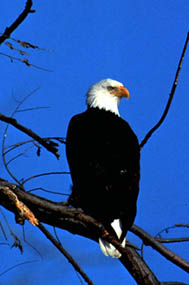By Jim Taylor, travel writer
Arkansas Department of Parks and Tourism
The sight of majestic bald eagles found in winter on Arkansas's
larger lakes and rivers -- the state's most publicized avian
attraction -- represents only a small, albeit spectacular, part of
the year-round opportunities for watching birds in The Natural State.
In all, 388 bird species have been recorded in the state, including
313 that have been observed regularly enough that the Arkansas
Audubon Society's most recent field list of birds provides detailed
information on their occurrence. |

USFW Photo |
Of the remaining species, 68, including seashore, pelagic and western
birds that have strayed from their normal ranges, have been seen
rarely in the state and, in many cases, only once. Seven of the
recorded species are now extinct or extirpated from their range in
Arkansas.
In addition to the bald eagles, winter brings to Arkansas a variety
of other raptors, interesting sparrows and an assortment of loons,
grebes, ducks, geese and gulls. Major concentrations of waterfowl
occur in eastern Arkansas, which lies along the Mississippi River
Flyway.
The first returning summer resident birds and migrants (birds passing
through on their way to breeding or wintering grounds) are usually
seen from early to mid-March, but the spring migration generally
peaks the first week in May. That's when the majority of the 36 wood
warblers recorded in the state are likely to be present, along with
grosbeaks, tanagers, orioles, thrushes and buntings.
Migrating northward through the state in early spring are shorebirds,
particularly sandpipers and plovers, which can be seen in muddy
fields along roadsides and in drained ponds at state fish hatcheries.
Shorebirds also migrate southward through Arkansas each fall.
Summer brings the opportunity to seek out the state's breeding birds,
including the rare red-cockaded woodpecker. Additional breeders of
interest are the colorful painted bunting, the hooded merganser and
heron and egret species.
Summer resident warblers include prothonotary, blue-winged, Northern
parula, yellow, chestnut-sided, black-throated green,
yellow-throated, prairie, cerulean, black-and-white, worm-eating,
Kentucky, hooded, common yellowthroat, yellow-breasted chat, American
redstart and Louisiana waterthrush.
Though the southward migration in late summer and fall generally
yields fewer species than the spring migration, it is the time of
year when such post-breeding wanderers as roseate spoonbills, wood
storks and grove-billed ani are most likely to stray into the
southern reaches of the state.
Arkansas has available for birding enthusiasts vast amounts of public
lands with generally open access, including the Ouachita, Ozark and
St. Francis National Forests and numerous state wildlife management
areas. Arkansans and state visitors seeking somewhat more targeted
birding opportunities can avail themselves of such sites as state
parks, national wildlife refuges, National Park Service lands and
state fish hatcheries.
In addition to popular eagle-watching events held each winter,
various Arkansas state parks host other events of interest to birders
during the remaining seasons. Information on such events can be found
on the Internet at
www.ArkansasStateParks.com/events/.
Details about Arkansas's state parks, including camping and lodging
facilities, can be found on-line at
www.ArkansasStateParks.com and
in the State Parks Guide, which is included in the free Arkansas
Vacation Planning Kit. The kit, which also contains an Arkansas
highway map, a Tour Guide and Calendar of Events, may be requested
on-line at www.arkansas.com or by phoning toll-free 1-800-NATURAL.
Millwood and Lake Chicot State Parks and their surrounding areas are
particularly popular among veteran Arkansas birders. The Lake
Millwood area has produced sightings of more than 300 bird species
and, like Lake Chicot and vicinity, is a good spot for winter
waterfowl and for seeking out post-breeding wanderers. Hundreds of
herons and egrets are seen most years at late summer roosts on Lake
Chicot.
One of Arkansas's most recent birding developments of note is the
rufous-crowned sparrows' extension of their range westward into
Arkansas. The birds have taken up residence at Mount Magazine and
Mount Nebo State Parks.
Other parks noteworthy for the variety of birds found on their waters
and hiking trails include Pinnacle Mountain, DeGray Lake Resort,
Village Creek and Devil's Den. Trail guides and park bird lists can
be requested at the parks' visitor centers.
Federally owned sites of interest to Arkansas birders include the
Holla Bend, Big Lake, Wappanocca, Felsenthal and White River National
Wildlife Refuges, the Buffalo National River and the Arkansas Post
National Memorial. Each provides varied habitats making for good
birding throughout the year. Felsenthal is home to the state's
largest population of the red-cockaded woodpecker.
Visitor centers at the federal sites can generally provide a map and
bird checklist. Brief site descriptions and bird lists for the
refuges and the river can be
viewed on-line .
State fish hatcheries of interest to birders for waterfowl and
migrating shorebirds include the Centerton hatchery near Bentonville,
the Hulsey hatchery near Hot Springs and the Hogan hatchery near
Lonoke. Hatchery personnel can direct birders to drained ponds for
observing shorebirds.
To obtain a copy of the Arkansas Audubon Society's current field list
for the state, send 20 cents plus a long, self-addressed stamped
envelope to Max Parker at 2426 South Main, Malvern AR 72104 or
Roberta Crabtree at 2036 Topf Road, North Little Rock AR 72116. The
list may be viewed on-line at
www.aristotle.net/~asca/ARlist98.pdf.
To learn about rare species recently spotted in the state, phone the
Audubon Society of Central Arkansas hotline at (501) 753-5853.
"A Birder's Guide to Arkansas," written by Little Rock resident Mel
White and published by the American Birding Association, provides a
detailed look at 59 of the state's best sites for birding. Included
are detailed directions, maps, best times to visit and what species
can be expected. The book, which also gives tips on where to find
selected species, can be purchased in local bookstores and state park
visitor centers.
|